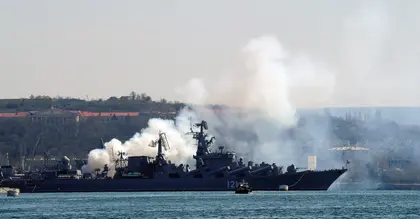The Russian Navy, once one of the world's most prestigious and feared, sailed a bit closer towards rust and disintegration on Monday. It announced in Russian and Ukrainian media that that the world's largest nuclear submarine by displacement, the Dmitry Donskoi, was being withdrawn from active duty and would be struck from Kremlin warship lists.
In 2022, Moscow official media reported that Russia was considering decommissioning the massive Typhoon class submarine, an intercontinental ballistic missile-carrying vessel designed to give Moscow the ability to launch undetected strikes with nuclear device-tipped missiles at targets worldwide.
- See the newest war in ukraine update from the Kyiv Post's news bulletins published today.
- See the most contemporary Ukraine news reports for today.
JOIN US ON TELEGRAM
Follow our coverage of the war on the @Kyivpost_official.
Russia's naval reputation took probably its most serious hit of the war in Ukraine in April 2022 when Ukrainian shore batteries using domestically developed Neptune anti-ship missiles sank the flagship and biggest warship in Moscow's Black Sea Fleet, the cruiser Moskva (Moscow), in a nighttime engagement.
 Flagship Moskva Sinking (credit BBC)
Flagship Moskva Sinking (credit BBC)
Reports at the time indicated that the Ukrainian military distracted the Moskva's air defense operators with a drone, allowing two sea skimming Neptunes to slam into the warship unimpeded. Russian authorities initially asserted the damage was from an on-board fire, a claim later rejected by survivors and naval officials. Estimates of sailors killed or drowned in the sinking have ranged from 40 to 600.
In October 2022, two Russian frigates, the Admiral Makarov and the Admiral Essen, were reportedly hit by Ukrainian remote-controlled motorboats carrying explosives. The spectacular kamikaze drone attack, taking place in the supposedly sacrosanct waters of the Black Sea Fleet's home base in Sevastopol harbor, deeply embarrassed Russian naval leaders. It also triggered accusations of incompetence and poor leadership even in Russian state-controlled media.

Moldova Residents Caught in the Middle of Gas Fight
Russian authorities claimed that the ships only suffered minor damage. Ukrainian authorities claimed the Markarov, the replacement Black Sea Fleet flagship, was crippled.
In March, a Ukrainian surface-to-surface ballistic missile hit the landing ship Orsk, sinking her at moorings in the port of Berdyansk. The Russian military claimed they raised the vessel in June.
According to Ukrainian news reports, in other engagements during the first six months of the war, the Black Sea Fleet warship Saratov also was sunk by a missile, and the warships Caesar Kunkov and Novocherkassk were struck but did not sink.
Ukraine's military has claimed it also destroyed three and damaged two Raptor Class patrol boats, in the vicinity of Snake Island, off-shore from Ukraine's Odesa region. Russian forces captured the strategic site controlling ship and air movement in the north-west Black Sea in March but abandoned it in late June after the Ukrainian military used long-range howitzers recently delivered from France to bombard the island.
Russia's naval capacity has deteriorated not only following Ukrainian strikes. In May 2022, two Russian ships, the landing ship Mitrofan Moskalenko and the destroyer Gremyaschiy, both caught fire while dry-docked in Murmansk, Russia. In June 2022, Russia's only aircraft carrier, the Admiral Kuznetov was out of service due to a lack of maintenance. In 2019 and again in 2022, the dry-docked ship caught fire, suffering severe damage.
Allegations of embezzlement of funds have swirled around the ship’s seemingly unending repairs. Russian authorities have claimed the damage will be put right and the ship will stay operational for another quarter of a century.
Russia's likely most notorious naval disaster took place in 2000, when the Russian nuclear submarine Kursk sank in water of 108 feet (32 meters) in the Arctic Ocean, trapping the crew at the bottom. Although the sea depth was less than the length of the ship, and other nations led by Britain offered high tech min-subs and highly-trained divers to assist, Vladimir Putin’s government refused international help proposals and attempted a rescue operation of its own. After several days, all 118 men on board succumbed to the cold and lack of oxygen and died.
Kursk Submarine before and after sinking. Credit: RFE/RL
The aging Russian Navy has suffered from a number of problems over the years due to a lack of maintenance, difficult recruiting and limited funding. In recent years the shrinking Russian Navy has been increasingly outpaced by the US and China, whose militaries are locked in an arms race for naval dominance of the West Pacific.
You can also highlight the text and press Ctrl + Enter










